

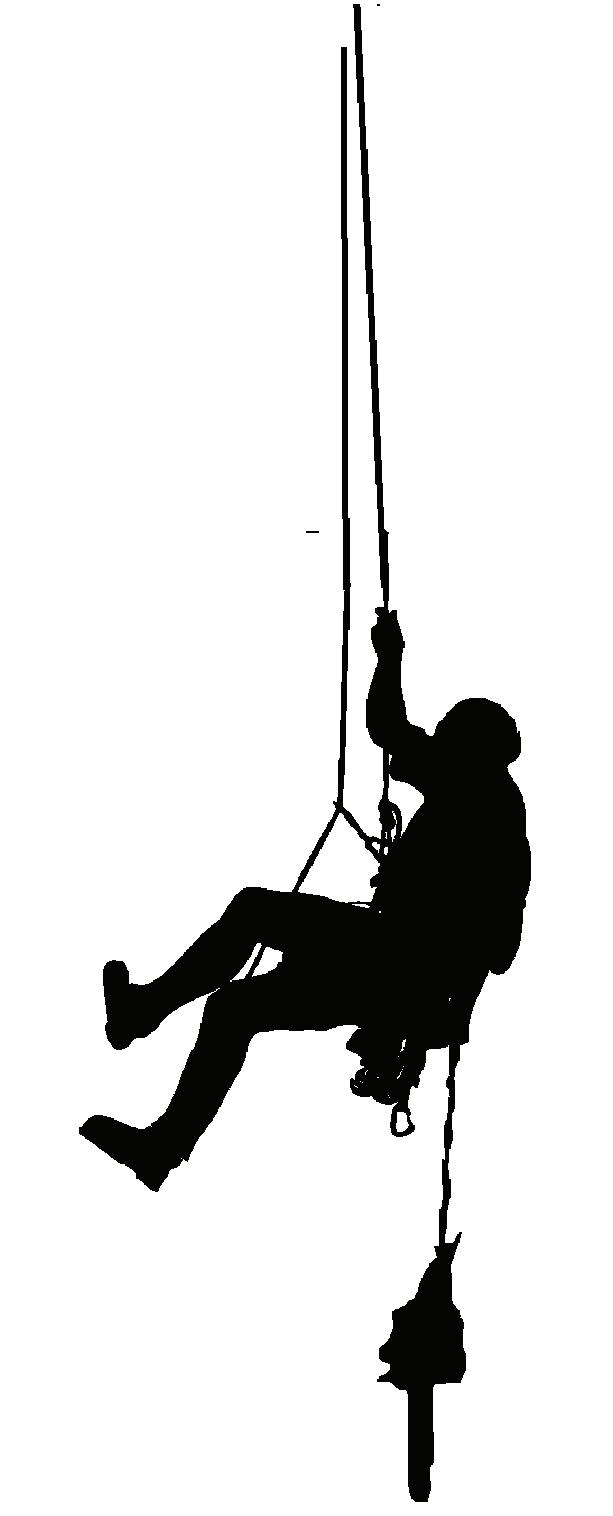

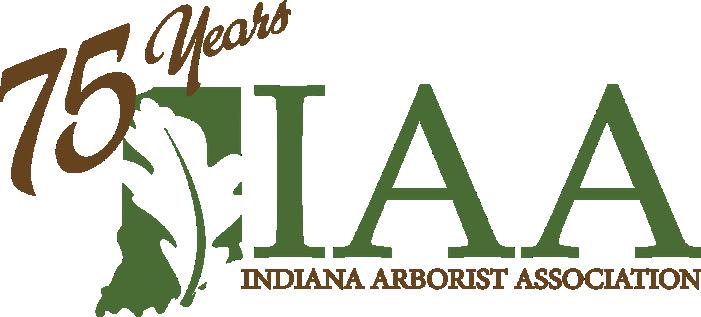
WINTER 2022
Board of Directors
President
Jon Xanders
Owner, Xanderbuilt Tree Care 820 E. Main Street Westfield, IN 46074 317-848-8885 jon.x@xanderbuilt.com
Vice President
Andrew Mertz 4444 Linton Lane Indianapolis, IN 46226 317-508-4909 Andrewsmertz@gmail.com
Secretary Henry Cox Community Forestry Manager ISA Certified Arborist IN-3576A Keep Indianapolis Beautiful, Inc. 1029 Fletcher Ave., Ste. 100 Indianapolis, IN 46203 o: 317.264.7555 ext. 133
Chapter Administrator
Lindsey Purcell Executive Director of the Indiana Chapter of the ISA ISA BCMA #1432b ASCA RCA #673 PO BOX 946 Cicero, IN 46034 Office | 219-295-0048
Past President
Cody Flint AES
IPL Line Clearing 1230 W Morris Street Indianapolis, IN 46221 317-261-4861 cody.flint@AES.com


IAA Chapter Representatives
ISA Liaison Rick Carter SaveATree LLC 4721 East 146th Street Carmel, IN 46032 (317) 846-3778 rcarter@saveatree.com
TREE Fund Liaison Tom Ordway Duke Energy 451 N. Boehning St. Indianapolis, IN 46219 Phone: 317-899-8971 thomas.ordway@duke-energy.com
Area Representatives
Utility Anna Byers Vegetation Management Specialist II 1619 West Defenbaugh St. Kokomo, IN 46902 Anna.Byers@duke-energy.com
Line Clearance Mike Rogers Synergistic Solutions 357 South State Road 135 Greenwood, IN 46142 Phone: 317-414-8689 mjrogers@iquest.net
Commercial Representative Joe Schultz
Nature’s Canopy 15268 Herriman Blvd Noblesville, IN 46060 joe@naturescanopy.com
Supplier
Stacie Songer Corteva 920-213-832 Stacie.a.nelson@dupont.com
Agency, Institution and Municipal Bill Kincius
Urban Forestry Manager City of Indianapolis 1200 S. Madison Ave, Indianapolis, IN 46225 317-327-7014 Bill.kincius@indy.gov
Nursery and Landscape Industry Representative Kyle Daniel Nursery and Landscape Outreach Specialist Department of Horticulture and Landscape Architecture Purdue University daniel38@purdue.edu Phone: 765-494-7621
Academic Education and Research Advisor

Clifford S. Sadof Professor and Extension Specialist Department of Entomology Purdue University, Smith Hall 901 West State Street West Lafayette, IN 47907-2089 Office: 765-494-5983; Fax: 765-494-2152 csadof@purdue.edu Landscape Entomology Laboratory
PSSA Representative Ben McCallister bmccalli@purdue.edu
Contacts
Newsletter Editor - Ashley Mulis IAA Business Manager ashley@indiana-arborist.org

Webmaster - Diana Evans
195 Marsteller
West Lafayette IN 47907 Phone: 765-494-3583 Fax: 765-496-2422 evans44@purdue.edu
P.O. Box 946 Cicero, IN 46034
Editors Note: There was an error in the article by Lee Huss, last issue, indicating that Harvey Holt was an executive director. In fact, Dr. Holt was the academic advisor on the board of directors while Ms. Rita McKenzie served as the executive director.
A note from the President...
Xanders, President, Xanderbuilt Tree Care

Hello fellow arborists and happy winter to all of you. Winter tends to be a “slow season” for most of us in this industry. It is a great time for reflecting on the season we just went through, and offers an opportunity to reflect on how we can better ourselves and our operations. I personally enjoy the wintertime because it’s conference season and we get a chance to get together, catch up, and further our knowledge. I truly am looking forward to seeing all of you very soon!
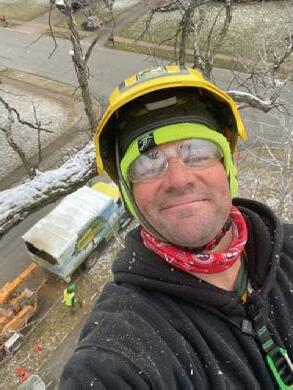

The tree industry is demanding. Physically and mentally, we need to show up, and put our best effort forward for our clients and employers. Whether you are in sales, management, ownership, in the field, or (like me), all of the above; every day presents a new challenge. This is one of the things I love most
about our industry. I always tell people that being an Arborist provides great character-building. We are all survivors out there dealing with the challenges it takes to get through the daily grind of our world. We use what we have and improvise to get the job done, hopefully all with a smile on our face because we love what we do. It is truly amazing what we can do if we put our heads together. I am grateful to all of you and the relationships that we have formed. If I am ever stranded on an island, I would choose to be surrounded by arborists because I know we can use our skills to survive and at the very least, have a good time doing it.
Being the President of this organization has allowed me to meet more of you than I would have in most settings. I appreciate the opportunity the IAA has provided for me as a member of this organization, as well as an arborist. I will continue to encourage any of you that would like to be involved to go for it, as we are stronger in numbers. Thanks to all of you for letting me represent this chapter of the International Society of Arboriculture and I will continue to be involved to best of my abilities. As always, be safe out there and I look forward to seeing many of you very soon.
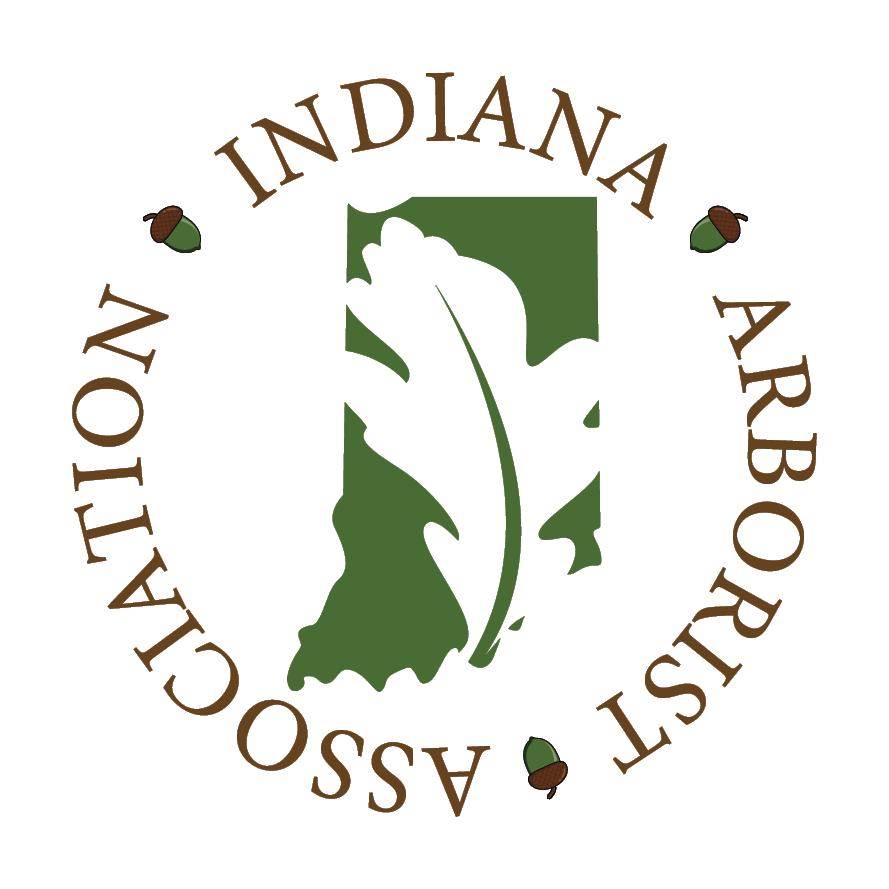 President Jon Xanders, Xanderbuilt Tree care
Jon
Jon Xanders, IAA 2022 Board President and Certified Arborist doing what he does best.
Photo credit: Ashley Mulis
President Jon Xanders, Xanderbuilt Tree care
Jon
Jon Xanders, IAA 2022 Board President and Certified Arborist doing what he does best.
Photo credit: Ashley Mulis
Either by accident or intention, most arborists have found a love for trees that landed a rewarding career in our industry. Our


tree care professionals enthusiastically enhance their practice of arboriculture on the job from mentoring, training and experience. Commonly, many arborists feel they have reached their learning limits and are ready to reach that next level of professionalism. Typically, a couple of options exist; return to school for formal education or training through continuing education opportunities. Going back to school is nearly impossible for most working professionals. Which leaves professional development as the best option and finding the right continuing education option is getting easier.
The winter season usually indicates that it is conference season for many of us. Arborist and other green industry associations are scheduling their events all over the Midwest. The latest and greatest research and presenters are providing that next level of education that many are looking for to improve our knowledge base. Typically, educational opportunities begin waxing when production is waning and the IAA is preparing for another great conference. These conferences are often some of the best alternatives for current and relevant knowledge at convenient locations. However, many professionals are unable to attend their local conference for many reasons. Either it is scheduled at an inconvenient time or perhaps costs are an issue. When making the decision to commit to the expense of a conference, don’t forget to factor in the hidden advantages of attending such as networking with peers and colleagues as well as the trade show. Often, many of those impromptu conversations leads to an expanded lessons and opportunities.
In addition to conferencing, your mobile device is always available as your personal university for higher learning. There are endless opportunities to catch webinars and podcasts from a multitude of organizations such as the International Society of Arboriculture, the US Forest Service or EAB University, or private organizations. If you can’t make
the live sessions, most are archived for viewing when more convenient. Even better, nearly all of them provide CEU credit!


Regardless of the preferred or most accessible learning model, take advantage of those less busy times whenever possible to expand your mind and improve your practice. Also, consider gaining credentials during the less busy months. This is a great time to get that ISA Certified Arborist credential or a specialist credential. I like the saying from the late, great Ray Kroc once said, “As long as you’re green you’re growing, as soon as you’re ripe you start to rot.”
Stay well, be safe…
800.423.3789 midwestarboristsupplies.com SUPPLIER OF THESE FINE PRODUCTS Arbor Jet • Mauget • Doggett • Nu-Arbor AlturnaMATS • Teufelberger • Felco • Fred Marvin Petzl • Quest Products • Samson • Silky • Sharp Edge • Weaver HELPING ARBORISTS
NOTHING LESS THAN TOUGH
.
Your job requires nothing less than tough. Whether you’re digging, cutting, shredding, loading or moving, we have one line of equipment versatile enough to make any job a whole lot easier. Ask your dealer today about our compact and grounds maintenance equipment.

BOBCAT OF INDY 2935 Bluff Road Indianapolis, IN 46225 317-787-2201
BOBCAT OF ELLETTSVILLE 700 East Temperance Ellettsville, IN 47429 812-287-8042
bobcatofindy.com
BOBCAT OF ANDERSON 2075 East County Road 67 Anderson, IN 46017 765-643-4222
BOBCAT OF HOWARD COUNTY 613 W Main Street Greentown, IN 46936 765-628-2800
BOBCAT OF COLUMBUS 890 N National Rd Columbus, IN 47201 812-775-1470
BOBCAT OF INDY NORTH 4489 S Indianapolis Road Whitestown, IN 46075 317-769-4946
Bobcat ® and the Bobcat logo are registered trademarks of Bobcat Company in the United States and various other countries. ©2022 Bobcat Company. All rights reserved.
Trees and Cemeteries!!!
Your local cemetery may have remarkable trees and much more.
Ash Program with a Twilight Tour on October 15. This is only the 6th program of this kind in its 169-year history. You can learn more about how to help in the fight against Emerald Ash Borer in Evansville by visiting evansville.adoptanash.org.
Crown Hill Cemetery Indianapolis offers a variety of tours from May through October. Presently there’s the Tombstones and Fall Trees Tour. “Crown Hill Cemetery is the largest green-space inside the Indianapolis beltway and the third largest nongovernment cemetery in the U.S. Each year, Crown Hill welcomes thousands of people to its grounds to visit the graves of those buried here, to participate in one of our many tours or events and to enjoy the solitude of the natural surroundings. There are many ways to experience the architectural, cultural and natural heritage of Crown Hill.” More than 4,100 inventoried trees featuring 130 distinct species are within Crown Hill’s 555 acres. Tree map
Oakhill Cemetery Arboretum in Evansville is a Level II accredited arboretum that was established in 2017. Oak Hill Cemetery is planning to reestablish their tree tours but right now their focus is on saving 23 ash trees from the emerald ash borer through an Adopt an
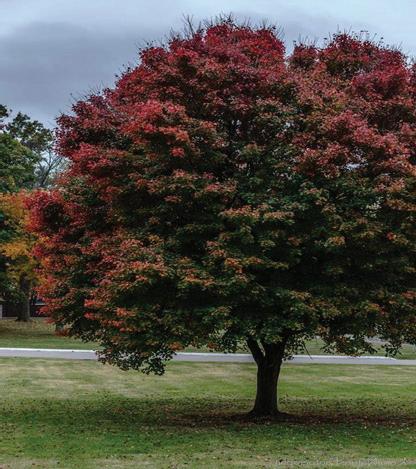

Locust Hill Cemetery and Arboretum in Evansville has a storied history dating back to 1835. It was homesteaded by the Robert Smith family, acquired by the Kirkpatrick family, and finally ceded to the City of Evansville. Among the trees, the arboretum was named for Corporal James Bethel Gresham, thought to be one of the first servicemen to die in WWI and buried at Locust Hill. In 2018 it became one of the 100 US places designated as a WWI Centennial Memorial.
Greenhill Cemetery Bedford - Trees of a different sort. This tree stump tombstone in the Oak Hill Cemetery in Crawfordsville, Indiana was created for the Hall Family. It is a great example of the unique designs that the stone carvers used to display the individual tastes and interests of the persons they memorialized with their craft.
According to Atlas Obscura, “tree-stump tombstones like these can be found in graveyards across the country. They date mostly from 1880s to 1920s, when funerary art in the United States was moving away from the grand mausoleums and obelisks. The tree-stump stones were part of a movement to turn the focus of death back to life, and they’re a unique form connected with the secret societies of the time. “They qualify as folk art,” writes Susanne Ridlen, in her 1999 book Tree-Stump Tombstones.
If your town has a cemetery with trees of interest to you, you can start your own plant map by using PlantsMap at plantsmap.com.

Take a walk on the Spooky side!!
Rita McKenzie, Retired IAA Executive Director
Crown Hill Becomes Only Accredited Arboretum in
Indianapolis and Central Indiana
Crown Hill awarded Level II Accreditation by ArbNet Accreditation Program, only global initiative to officially recognize arboreta

Tiffany Whisner, Coles Marketing 317-571-0051 twhisner@colesmarketing.com
INDIANAPOLIS (Nov. 4, 2022) — The Crown Hill Heritage Foundation is proud to announce the establishment of the Crown Hill Arboretum, which has been awarded a Level II Accreditation by The ArbNet Arboretum Accreditation Program and The Morton Arboretum for achieving particular standards of professional practices deemed important for arboreta and botanic gardens.
The ArbNet Arboretum Accreditation Program is the only global initiative to officially recognize arboreta at various levels of development, capacity and professionalism. The Crown Hill Arboretum is also now recognized as an accredited arboretum in the Morton Register of Arboreta, a database of the world’s arboreta and gardens dedicated to woody plants.
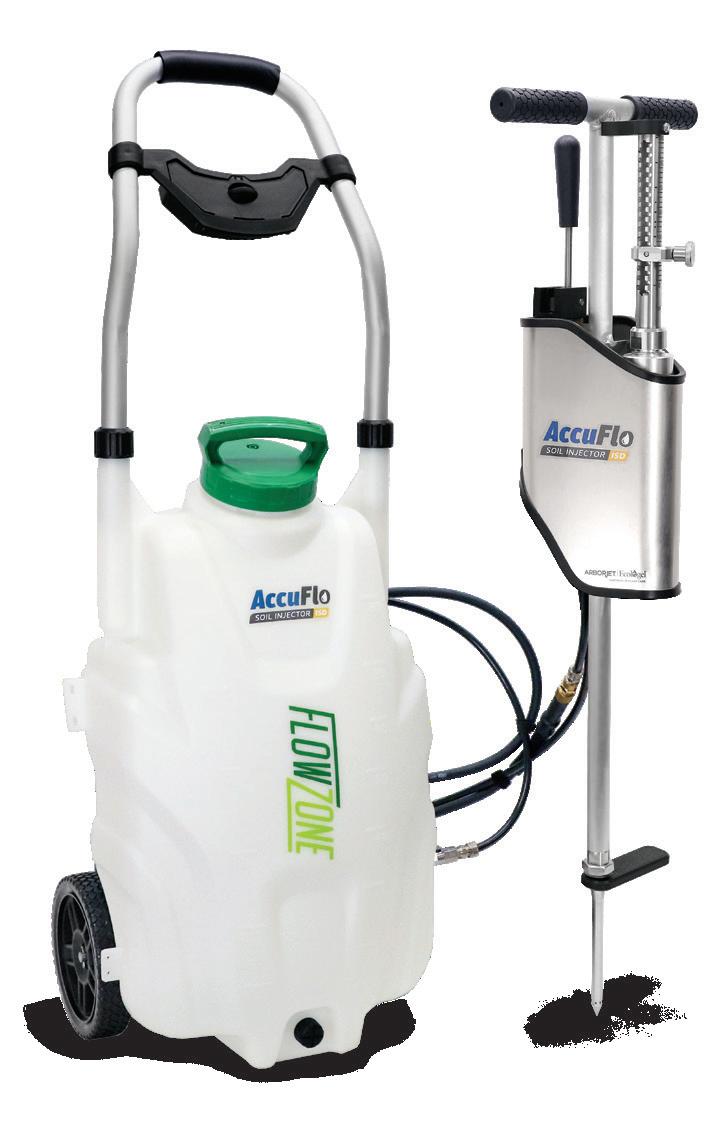

“We are honored to have received this accreditation from ArbNet,” said Crown Hill President David Rieck. “The Crown Hill Arboretum is now the only accredited arboretum in Indianapolis and central Indiana as well as one of only five Level II or higheraccredited arboreta in the state of Indiana. It is also the thirdlargest non-governmental cemetery arboretum in the country.”
“This accreditation is major news for Indy’s native trees and ecology,” said Mayor Joe Hogsett. “However, by preserving the integrity of some of the oldest growth in the city, Crown Hill Arboretum also contributes to the goals of Thrive Indianapolis — the city’s first sustainability strategy. Today’s recognition demonstrates that one of the most historic sites in our community is committed to a cleaner future.”
The roots of the arboretum project reach back to 2003, when the Purdue University Department of Forestry and the
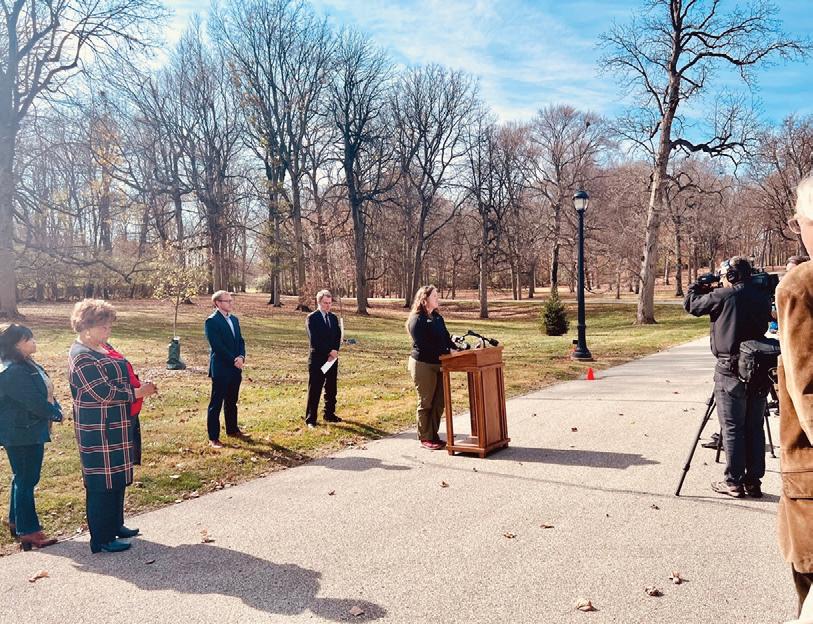 CeremonyPhotoofCrownhillHeritageFoundation Arboretum Director Carrie Tauscher
CeremonyPhotoofCrownhillHeritageFoundation Arboretum Director Carrie Tauscher
Arbor Rx® and AccuFlo ISD® Working SMARTER Better works together Visit us at arborjet.com and See How Better Works Together. + Get healthier roots and soil with less work. ArborPlex forms the basis of our Arbor Rx program, a prescriptive line of soil enhancement products for any problem or situation, including lack of nutrients, poor soil health, or water availability. Make sure you’re using the exact right amount of product with the versatile, portable, and intuitive AccuFlo ISD, now with a 9 gallon roller tank. Make growing conditions better for trees and plants with total ease.
PhotoCredit:StephanieErtel
Indiana Department of Natural Resources (DNR) identified and marked more than 4,000 trees and 130 species on the grounds.

“Part of the mission of the Crown Hill Heritage Foundation is to preserve the natural heritage of the cemetery,” Rieck said. “A big part of that heritage is the landscape and the trees. Crown Hill is the largest canopy of trees inside the city of Indianapolis and provides many ecological benefits. By becoming an accredited arboretum, we are being intentional in the care, conservation and enhancement of our tree collection. In addition, we are committed to the education and engagement around trees and our natural environment.”
As a Level II-accredited arboretum, Crown Hill has both on arborist on staff who provides for the basic needs of the arboretum collection and functions of the arboretum as well as a director of education and engagement who will plan enhanced programming to the public focused on trees and the natural environment.
There is no cost to visit the grounds at Crown Hill Cemetery. Guided tours have registration fees specific to each tour. Visitors are welcome on site during regular cemetery hours: 8 a.m.-6 p.m. October through March and 8 a.m.-8 p.m. April through September.
For more information about visiting Crown Hill or learning about the Crown Hill Arboretum, visit crownhillhf.org.
About Crown Hill Heritage Foundation
The mission of the Crown Hill Heritage Foundation is to
preserve and celebrate the architectural, cultural and natural heritage of the city’s oldest urban greenspace, Crown Hill Cemetery. Through our work, we preserve and restore historic buildings, mausoleums, iconic monuments and precious artwork; educate the community through our many public and private tours and events that celebrate the history of our city, state and country and the natural surroundings; and preserve and enhance the cemetery’s natural beauty through tree plantings and cultural landscape section preservation. For more information, visit crownhillhf.org.
About ArbNet ArbNet is an interactive, collaborative, international community of arboreta. ArbNet facilitates the sharing of knowledge, experience, and other resources to help arboreta meet their institutional goals and works to raise professional standards through the ArbNet Arboretum Accreditation Program. The accreditation program, sponsored and coordinated by The Morton Arboretum in Lisle, Illinois in cooperation with American Public Gardens Association and Botanic Gardens Conservation International, is the only global initiative to officially recognize arboreta based on a set of professional standards. The program offers four levels of accreditation, recognizing arboreta of various degrees of development, capacity and professionalism. Standards include planning, governance, public access, programming and tree science, planting and conservation. More information is available at www.arbnet.org.
Diagnosing Phytotoxicity on Landscape Plants
Kyle Daniel, Nursery and Landscape Specialist, Purdue University
Email: daniel38@purdue.edu
Phytotoxicity is damage to plants caused by chemicals, fertilizers, or pesticides. Phytotoxicity can be a positive (killing weeds) or a negative (damage from pesticides on ornamental plants), depending on the intended results. Some of the common phytotoxic effects can show symptoms such as stunting of leaves and whole plant, necrosis (death), chlorosis (yellowing), abnormal growth (i.e. twisting/epinasty, cupping), discoloration, root damage, or bark cracking.
The most common reasons for phytotoxic symptoms include:
Herbicide injury
Herbicide phytotoxicity can occur when drift, volatilization, or other misapplication occurs when a herbicide is applied. The symptoms vary widely depending on the herbicide mode of action and the plants that are damaged. All of the symptoms mentioned above can occur when damage is caused by herbicides.
Fertilizer burn
Fertilizer phytotoxicity can occur when a liquid fertilizer is applied to leaves during hot temperatures and low humidity. Fertilizer burn can also be caused by high electrical conductivity (EC) (salts from the fertilizer) in the soil. Typical symptoms include necrotic (dead) plant tissue at the margins of the leaves. To correct the high EC in the soil, deep irrigation can be applied to leach out the salts or gypsum can be applied around the root system to deactivate the salts.
Insecticide/Fungicide applications

Typically insecticide and fungicide applications don’t cause any type of phytotoxicity to plants, though when applied during extremely hot temperatures they can cause some damage. To prevent this from occurring, apply during the early morning hours and avoid any of these applications in
the middle of the day during the hottest days of the summer. Typical symptoms include necrotic and/ or chlorotic damage to the entire leaf area.

Improper tank cleaning
Proper tank cleaning is essential when using multiple types of pesticides (i.e. herbicides, insecticides, etc.) or modes of actions of herbicides in one tank. You would typically observe the worst damage where the application began and decrease in damage as the spraying continues through the landscape/plants.
To diagnose phytotoxicity, there are some key steps:
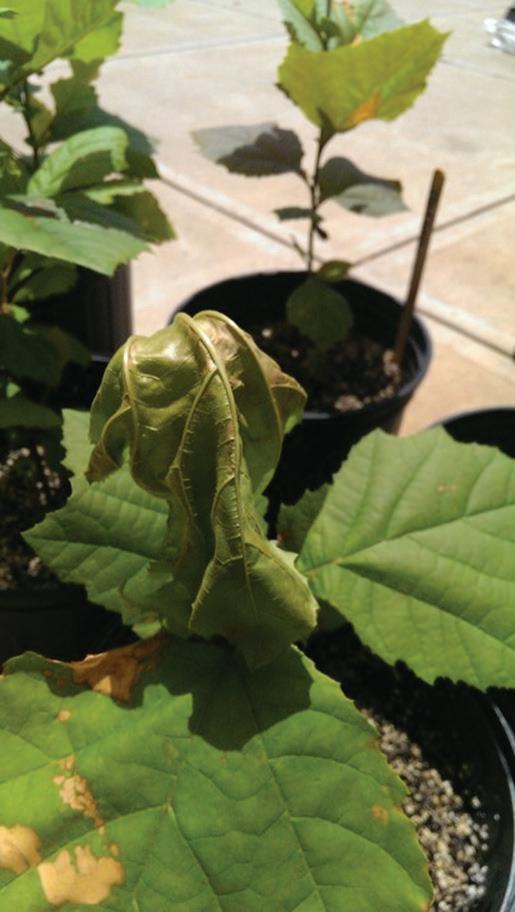
1)Find out the history of the site. a.Previous pesticide and fertilizer usage in the area. b. Weather conditions when applications were made to the site.
2)Diagnose abiotic vs. biotic symptoms. a. Are the symptoms random (biotic) or in a pattern (abiotic)?
i. If abiotic, whole plants and/or multiple plants will be affected.
ii. If biotic, symptoms will be on various parts of the plant with no pattern.
3) What are the symptoms? a. Does the history of the site indicate the cause could be due to past applications?
4) If a determination can’t be made, send samples to the Purdue Plant and Pest Diagnostic Lab.
Figure1.Herbicidephytotoxicityto sycamorefrom2,4-D.
Figure2.Insecticidephytotoxicityfromanapplication madeinanurbanareawhiletemperaturewereinthe90’s.
Did
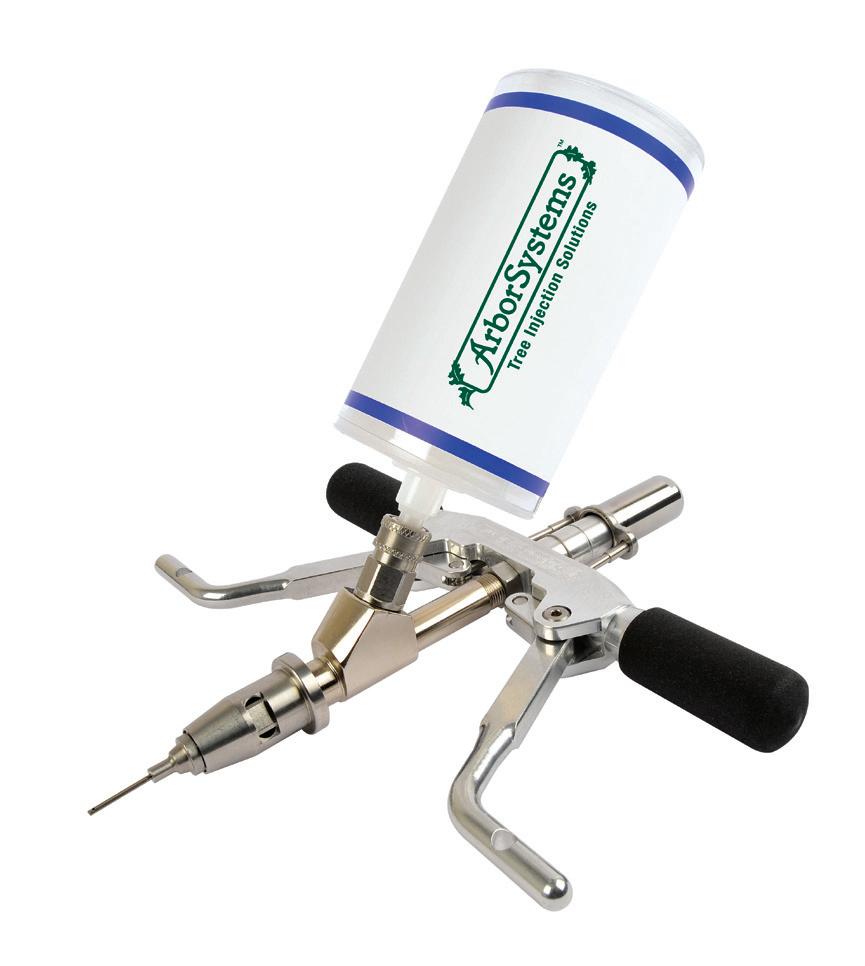

know... President Benjamin Harrison had the first Christmas Tree in the White House?
Though no pictures exist of President Harrison’s tree, the Benjamin Harrison home in Indianapolis decorates the front parlor like it might have looked.
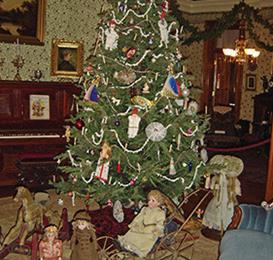

Mary Harrison McKee (Harrison’s daughter) wrote to her husband describing the first Christmas that the Harrison’s spent at the White House in 1889. The Harrison’s 1889 Christmas tree is described as a large gorgeous tree trimmed by the President, his family, and staff. It carried toys not only for the children of the family but for everyone attached to the White House and their families.
“Such a day as yesterday was for all of us. I wished so often for you and you should certainly have had as much pleasure as one could wish out of watching Benjamin and Mary… We hung up stockings for each of the children and put a few little things in them. Benjamin thought it was great sport when
he woke up in the morning… After breakfast we lighted the tree (almost half past ten) and I do wish you could have seen Benjamin and Mary as I took them into the room. I had the tree put into the room upstairs that we used last year for the nursery. We could darken that so well and as it is not in use at present the children can enjoy their tree for several days. We called all the employees and servants in and I think they were as much pleased as the children. Papa gave each man who has a family a turkey and those who have not a pair of gloves. We also had some little remembrances for the cooks, laundresses, waiters, and those that are immediately around us… I gave mama a pair of gold side combs for her hair and papa a pocket piece – it is a silver dollar so arranged that it opens and contains a place for a picture…
You might want to visit his home in Indianapolis at any time of the year. https://bhpsite.org/

ArborSystems.com 888-557-2455 BannerSales360@gmail.com www.bannersales.net Our advanced technology for tree treatment allows you to INCREASE THE NUMBER OF TREES YOU TREAT IN A DAY! Multiple injection tips designed for all types of trees, conifers and palms Insecticides • Fungicides • PGRs • Antibiotics • MicroNutrients ◆ No drilling damage ◆ No mixing at job sites ◆ No guarding or return trips ◆ No waiting for uptake ◆ Treats most trees in five minutes or less! ◆ Successful and most profitable add-on service
you
Mertz,
Incoming IAA President
What do Fender guitars and Lindsey Purcell have in common? Give up? - both have roots in Indiana.
In a tiny town in Dekalb County, a Saint Joe business, EcoVantage, processes wood for Fender Musical Instruments Corp, better known as Fender guitars.
EcoVantage uses mostly maple from the Midwest for the necks of Fender guitars. Their wood processing treatment helps the guitars tolerate changing weather conditions particularly when playing outdoors, the guitar maintains a consistent tone because the processing reduces the absorption of moisture.

For the more technically minded, EcoVantage “uses a process called thermal modification, a combination of heat and steam, that makes the wood rot resistant, more durable and better protected against moisture.”
Many more artisans derive their instruments from Indiana woods.
For example, Wayne Gaydos of Randolph County was inspired to create beautiful music in his From the Woods studio by combing his love of music and woodworking. He “selects the wood, designs the soundboards, and styles each instrument and sound holes”. Making each dulcimer, mandolin, psalterie and harp a unique instrument.
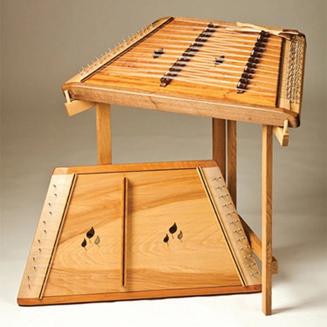
Tim Garst of Archaic Guitars in Indianapolis uses Indiana black walnut back, sides & headstock veneer Indiana black cherry neck, and Indiana sycamore binding in his L-0 model that he made in 2021. Listen to Tim play this guitar - on youtube
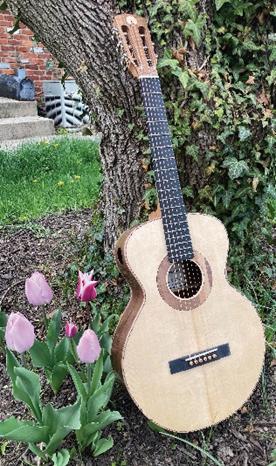
Other folks that you might consider contacting would be Brian Carver of Carver Banjos - He uses a solid American Walnut for all of his banjo kits (though I don’t know for
certain that it is from Indiana, specifically). We do carry his banjos here at the shop, as well. https:// carverbanjos.com/contact/
Bill Arnold of A Joyful Noise Dulcimers, who is one of our most prominent dulcimer builders, also frequently crafts his dulcimers from Maple, Sassafras, Black Walnut, and Cherry. Though, I don’t know for certain that it is all sourced from Indiana specifically, I imagine he does try to source locally when possible. Reach Bill is through Facebook https://www.facebook.com/AJoyfulNoiseDulcimers
ISA Leadership Workshop
I had the opportunity to attend the 2022 ISA Leadership Workshop in October at ISA headquarters in Atlanta and represent our chapter. The focus of the workshop, especially for Chapter Board of Directors, was on the governance of the board. Topics included: • The Role of the Chapter Board of Directors
The Role of the Executive Director and Professional Staff
The Role of Committees
Common Roadblocks that Impact Chapters
The Importance of a Strategic Plan
Succession Planning
If there is one issue that many Chapter Board of Directors struggle with across the board, it is succession. Although all of our board seats are filled, our chapter has struggled with
Page 12 Indiana Wood and Music
•
•
•
•
•
IAAExecutiveDirectorLindsey PurcellplayinghisFenderGuitar. Photo Credit: Rita McKenzie
Andrew
identifying qualified candidates to fill board positions. It is a constant struggle to recruit candidates for key roles, including Secretary and President.
Other than succession, our Indiana Chapter, compared to other chapters, is performing very well. Highlights of our Chapter performance includes:
• Fiduciary Responsibility and Performance. We are one of a few Chapters that invests funds to maximize return on investment.
• Board members understand their roles and responsibilities as do the Professional Staff
• The relationship with the Board and Professional staff is excellent
• The board works very well together, and meetings are well attended
• Events (annual conference, golf outing, tree climbing championship), are well attended and well-reviewed by participants.




• The board has a strong relationship with similarly aligned groups such as INLA and Saluting Branches.
Perhaps one of the biggest reasons to attend the workshop is to share experiences with other chapter Board of
THE ARBOR PRO SERIES
THE BEST JUST GOT BETTER
The Arbor Pro Series by CMC are the ultimate tracked aerial lifts designed specifically for tree care in America. With extreme working height and side reach, they are also capable of entering standard 36” gates with ease. They come in a lightweight & compact package, and also feature multi-position compact footprints. Call us today to request a quote and schedule a demo!


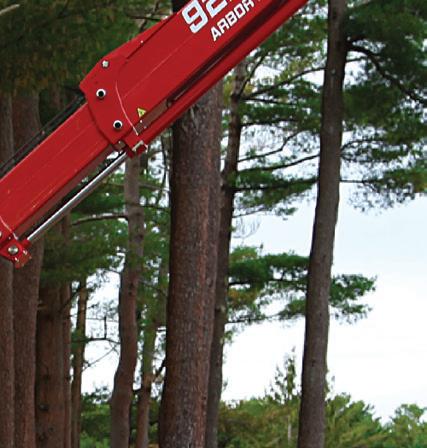

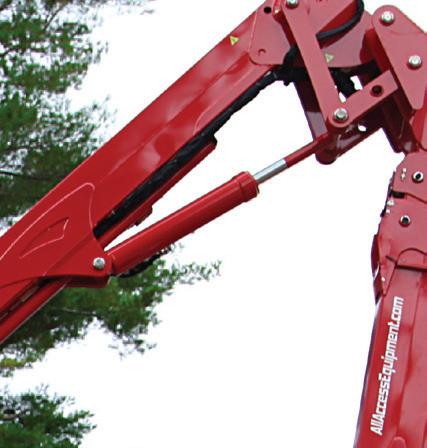






allaccessequipment.com (978) 715-4950


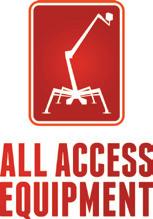
Directors and Executive Directors. After discussing the many issues that other boards have, I think our Indiana Chapter is in really good shape comparatively speaking. It was also good to have access to the ISA professional staff and the ISA Board of Directors.
Lastly, if anyone has the opportunity to attend the workshop in the future and represent our chapter, I strongly encourage you to go.
Page 13
ISALeadershipConference2022-Atlanta,GA
Beware the Honeydew List
Cliff Sadof, Department of Entomology, Purdue University
In early to mid-summer when sucking insects are active and rain becomes less frequent the liquid excrement of sucking insects, called honeydew can accumulate on leaves. The sweet sugary honeydew can create a nuisance when it attracts stinging insects to the leaves or a shady seating area beneath the tree. The sticky coating itself can be a problem when it coats your windshield or pits the finish of your car. In this article I will cover how you can reduce the problems with insecticides and by using my honeydew list (Table 1) to avoid planting trees that are prone to sucking insects near parked cars and picnic tables.
Unlike mammals, insects consume plants by either chewing or sucking- not both. The waste products of dedicated chewers like bagworms and eastern tent caterpillars are in a dry pellet form that entomologists call frass. The excrement left by insects who suck plant sap is a sugary liquid that is rich in protein that we call honeydew. This liquid is excreted as clear droplets that build up on leaves and branches. In the absence of rain that washes off the honeydew, it can accumulate making the leaves appear shiny as if coated in a sugary glaze. In time, the honeydew can become contaminated with a black sooty mold giving the leaves and branches a black appearance. The sticky honeydew is an important source of nutrition for insects that pollinate plants, including butterflies, moths, bees, wasps and flies.
Figure1.Alargedroplet ofhoneydewproduced bythisadultfemale spottedlanternflyis clearlyvisibleattheend ofitsabdomen(Photo byE.Barnes).
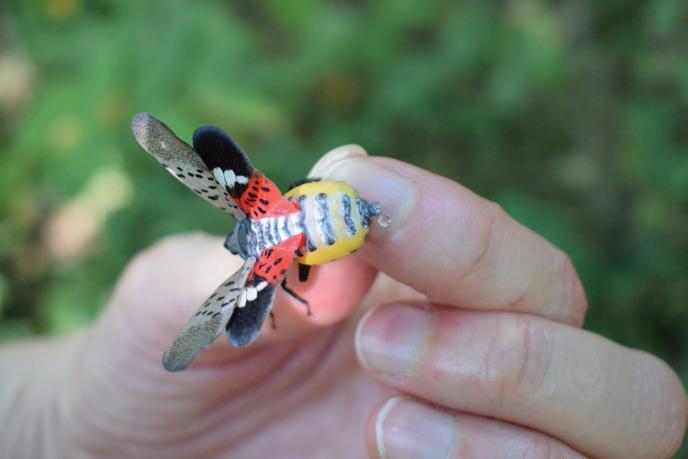
Figure3. Tuliptreeaphids (leafonleft)produced honeydewthatturned blackwithsootymold (rightleaf)(PhotobyJ. Obermeyer)
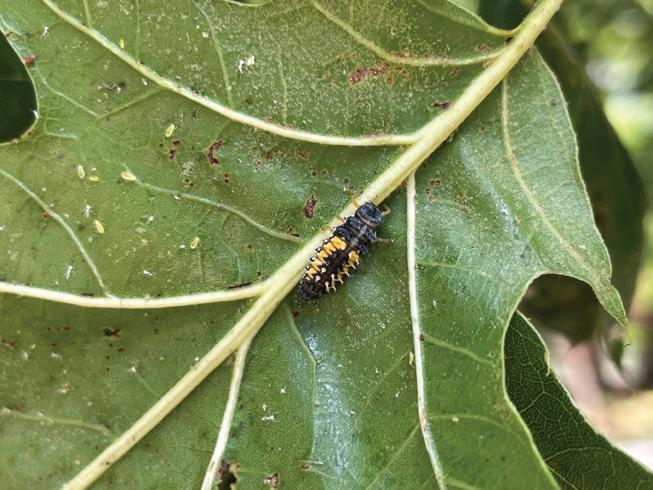
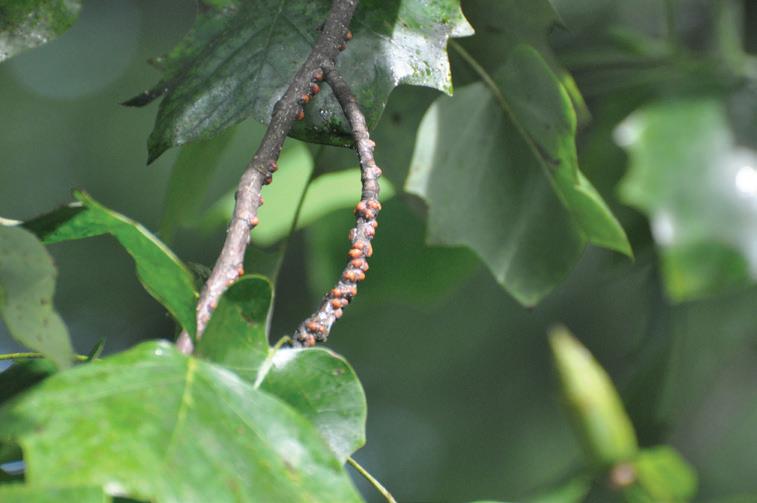

Figure2. Dropletsof honeydewproduced bythetuliptreeaphid accumulatedduringdry weather.(PhotobyC. Sadof)
Figure4.Brownand
onthistwigexcreted liquidhoneydewthat becameinfestedwith blacksootymold.
Common sucking insects that feed on trees and excrete include aphids, soft scales, mealybugs and the newly introduced spotted lanternfly. Each of these insects have tube like mouthparts that penetrate leaves or thin bark to feed on liquids moving through the plant circulatory system. For this reason, you will often find aphids, scales and mealybugs feeding close to leaf veins.
Unfortunately, it is often difficult to control honeydew producing insects on trees with insecticides. Foliar sprays like insecticidal soap, horticultural oil, or insect growth regulators like pyriproxyfen or buprofezin, can be quite effective, but it is often difficult to get effective spray coverage unless you hire a professional. Soil applied systemic insecticides (acephate, imidacloprid, dinotefuran) can be quite effective against aphids and soft scales, but they can kill pollinators attracted to the flowers. New research has shown that when applied to the soil, sucking insects can excrete enough insecticides in the honeydew insecticide to kill beneficial insects.
Probably the best way to avoid problems with honeydew producing insects is by not planting trees likely to get these pests near parked cars, picnic tables or highly trafficked areas. Use the following table of common street trees to help guide your tree selection. I have compiled this list based on informal notes I have taken on sucking insect problems I have encountered over the last 3 decades.
Figure5.Ladybeetlelarva
Trees like honeylocust and several species of oaks are on the top of my list of most likely to have honeydew problems.

Page 14
orangetuliptreescales
Although the soft scales attacking honeylocust rarely will kill a tree, they have caused enough of a nuisance in some communities to have residents remove their honeylocust trees. Problems with kermes scale on oaks have been documented in an earlier issue of the Purdue Landscape report. Tuliptree poplar is another tree that dependably gets coated with honeydew by and aphid or soft scale somewhere in the state every year. The last tree on the high list is the tree of heaven. This is another invasive plant that is also attacked by the spotted lanternfly, the latest exotic pest to enter Indiana. As you can see from Figure 1 it produces copious amounts of honeydew.
Diagnosing Sucking Insect Problems.
Use the Purdue Plant Doctor Apps, or the Purdue Plant Doctor Website (PurduePlantDoctor.Com) to identify and get management advice sucking insects as well as many other pests and diseases.
* Invasive tree, do not plant, and remove if possible.
** Invasive pest, not yet widespread in Indiana. Call 1-866 No Exotic or use Purdue Plant Rx web page to report
•
• Drainage
• Storm and disaster emergency response.
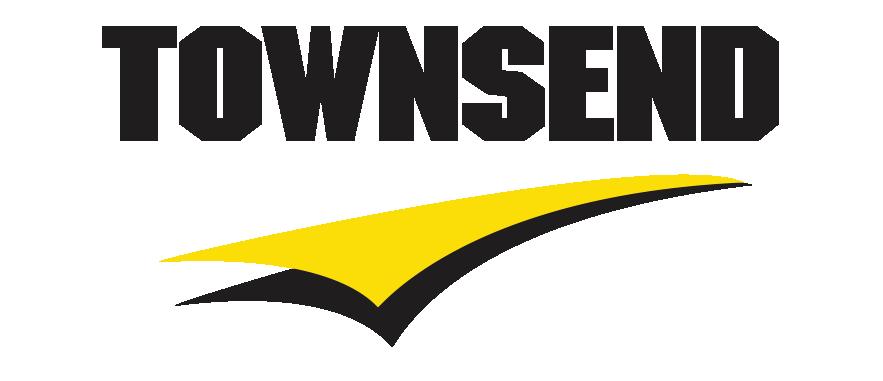
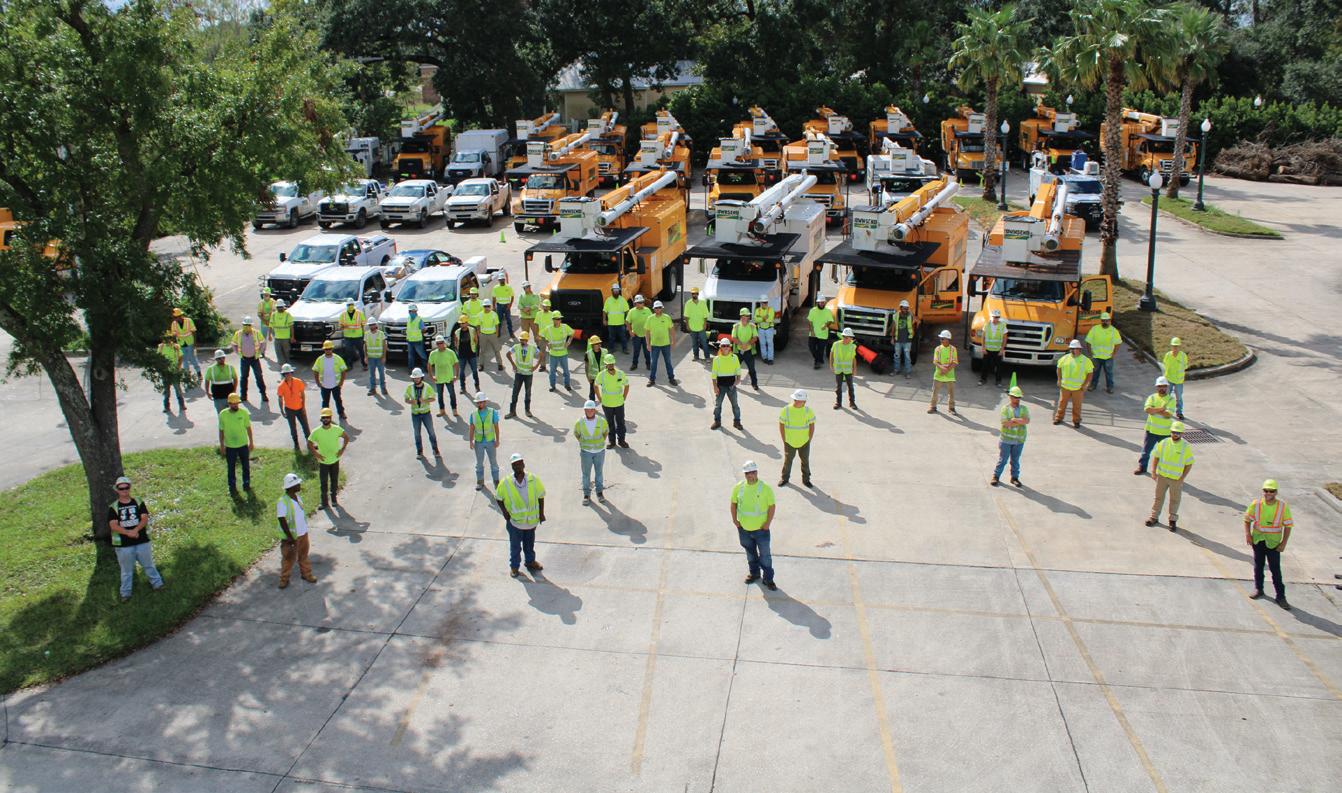
• Chemical and herbicide

Page 15
For more than 75 years, Townsend Tree Service has been helping customers across the country meet their IVM goals by providing world-class service in the following areas:
Utility, pipeline and transportation line clearing, maintenance and growth control.
and right-of-way clearing, maintenance and growth control.
Find out how we can help you. We’re not servicing trees. 800-428-8128 • 765-468-3007 info@townsendcorporation.com • www.townsendcorporation.com We’re servicing customers.
applications.
Join Us for the IAA’s 76th Annual Conference

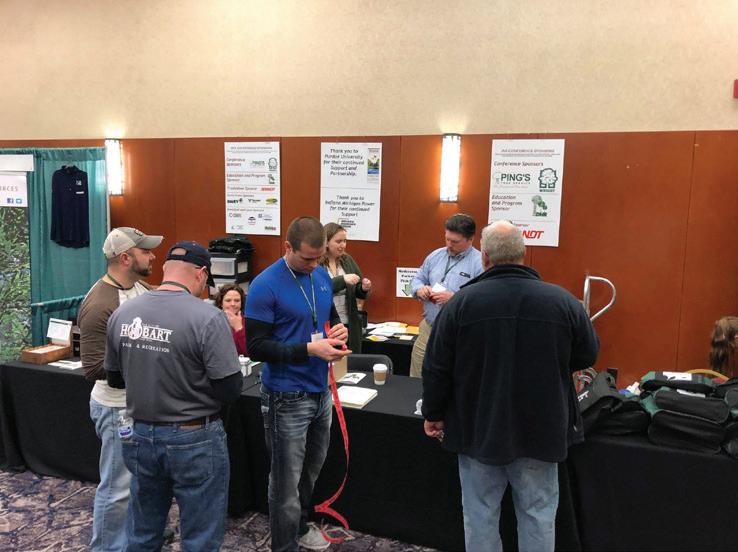
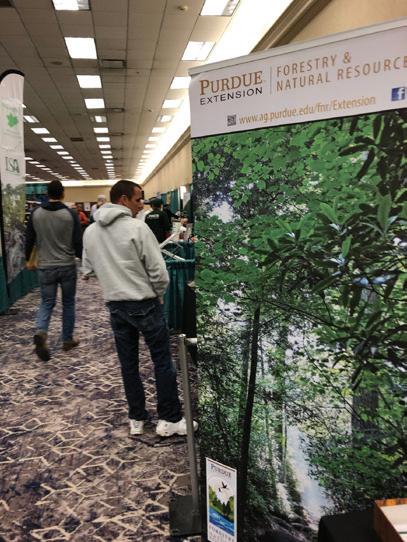
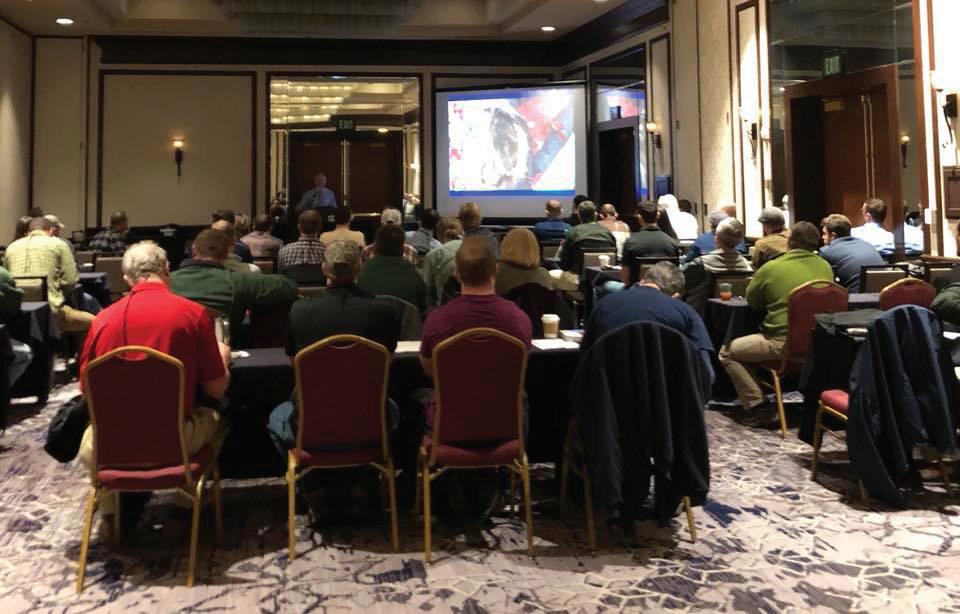


Page 16
For registration and sponsorship opportunities visit
Platinum Sponsor Titanium Sponsor Thanks to our sponsors:
-Featuring Keynote Speaker Steve Haffner as he entertains and informs with his presentation “From a-Ha to ta-Da!” -A packed agenda offers the credentialed arborist 29 CEU and 9 CCH - Visit our tradeshow floor and network with your arborist and industry friends and colleagues - Demonstrate your axe throwing prowess at our annual social event—includes dinner and transportation
www.indiana-arborist.org
Tuesday,
January 24 Urban Forestry Program
Welcome and Introductions Lindsey Purcell, Director, Jon Xanders, President 8:45 am
Crown Hill Canopy: Health Impacts Haleigh Kampman, IUPUI 9:45 am
10: 30 a m Urban Forestry’s Historical and Future Roles in Community Health and Equity Stephanie Miller-Foster, Ohio DNR 10: 30 am

Karber,
Tree Risk Management for Communities Lindsey Purcell, Lp Consulting Group 4: 30 pm - 5:00 p m IAA Business Meeting; open to all members- Harrison Room 5: 00 pm
Page 17
2 | Page
7:30 am Registration Open (Liberty Hall) 8:30 am – 8:45 a m
– 9:45 a m
–
– 11:00 a m Break for Networking
11:00 am – Noon
IAA Annual Awards Program, Richard
Awards Chairperson Updates and Information from ISA Noon – 1:00 p m Lunch 1:00 – 2:00 p m Urban Forest Inventory and Analysis in the US Mark Majewsky, USFS 2:00 – 3:00 p m Climate Change Impacts on Urban Forests Grant Domke, USFS 3:0 0 – 3: 30 p m Break for Networking 3 : 30 pm – 4: 30 p m
– 7 :00 p m Hospitality Event on Tradeshow Floor
Conference Agenda At-A-Glance 2023 Indiana Arborist Association 76th Annual Conference
3 | Page
January 25 7:00 am – 4:00 p m Registration Open (Liberty Hall) 7:00 am – 8:00 a m Breakfast on Trade Show Floor (Liberty Hall) Track Selection Utility/ Applicators Salon 3 Arboricultural Practices Salon 5 Commercial/ Contractor Salon 6 8:00 am – 9:00 a m Monarch CCAA: Overview of a ROW Permit and Partnership Program Stephen Beard, Duke Energy Coincidentally Rigging Don
Wright Tree Tree
9:00 am - 10:00 a m Using the Purdue Plant Doctor Website to Diagnose Problems and Report Invasives Cliff Sadof, Purdue University Finding Safety in Tree Felling Don
Wright Tree Service Urban Roots Jake
Morton
10:00 am – 11:00 a m Break with Exhibitors Liberty Hall 11:00 am – 12:00 p m A Spruce for Every Problem! Jon Bonkowski, Purdue University Aerial Rescue Travis
Noble Oak Training Boundary Laws and Trees Kent Frandsen, Parr Law Attorneys 12:00 pm – 1:30 p m Indiana Arborist Association Luncheon: New President Welcome and Past President Recognition Liberty
pm – 2:30 p m Keynote Presentation: Steve Haffner From
to ta-Da! 2:30 pm – 3:00 p m Break with Exhibitors Liberty
3:00 pm – 4:00 p m Googling Sleep? From Apnea to Zzz Alejandra
of Chicago 4:00 – 5:00 p m Tree Rings, Disturbance, and Environmental History
of Louisville 6:00 pm – 10:00 p m Social Activity See Registration Desk for Tickets and Details
Indianapolis Marriott East 7202 East 21st Street Indianapolis, Indiana 46219
WEDNESDAY,
Watson,
Care Industry Safety Trends Mike Tilford, Savatree
Watson,
Miesbauer,
Arboretum
Vickerson,
Hall 1:30
a-Ha
Hall
Lastra MD, University
Meagan Rochner, University
Leadership at the Crew Level
Travis Vickerson, Noble Oak Training
Climbing Equipment Inspection Mike Tilford, SavATree 9:00
Spotted Lantern-Fly Update Cliff Sadof, Purdue University Why is my tree Dying? Janna Beckerman, Purdue University Do you know what you are buying? Alex Julius, Davey Tree Experts 10:00
Securing Your Pesticide Load Fred Whitford, Purdue University
Message from ISA Certification and Qualification Essentials Lindsey Purcell, IAA 1:00
Kyle Daniel, Purdue University
Storm Restoration Pruning Jake Miesbauer, Morton Arboretum
Safety, the higher level Scott Jamieson, Bartlett Tree Experts 2:00

Office of the Indiana State Chemist: Updates and Information

Aaron Kreider, OISC
Conference Close; Thank you for attending!
Page 18 Page THURSDAY, January 26
am – 1 2 :00 p m
–
a m
–
a m
7:30
Registration Open (Liberty Hall) 7:30 am
8:30
Breakfast on Trade Show Floor (Liberty Hall) Track Selectio n Utility/ Applicator Salon 3 Arboricultural Practices Salon 5 Commercial / Contractor Salon 6 8:00 am
9:00
Post glyphosate options in aquatic environments for vegetation control Stacie Songer, Corteva
-
a m
am
10:00
–
a m
–
a m
–
p m
–
p m
–
p m
am
10:30
Break with Exhibitors 10:30 am
11:30
11:30 am
12:30
Indiana Arborist Association Luncheon Raffle & Silent Auction Wrap-Up, Final Break with Exhibitors, Secretary Vote Liberty Hall 12:30 pm
1:00
pm
2:00
Selecting the best preemergence herbicides for your landscape
–
p m
pm
3:00
2022 IAA Golf Outing
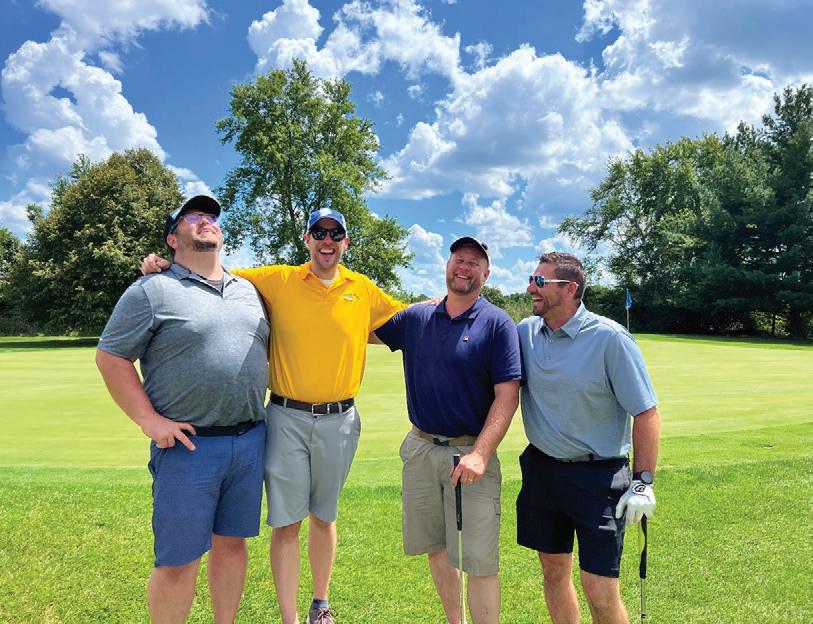
They say old golfers never die they just stroke out. Medical stats show that laughter has long lasting medicinal value. There were plenty of strokes and a lot of laughs from the old and no so old tree ‘fellers, at this year’s annual event at Crestview. A big ‘Thank You’ to Jason Swoveland and Townsend for coordinating this event. Special ‘Thanks’ to Ashley and Crestview for support and a beautifully well managed venue.
Over 60 golfers and volunteers, 14 teams and some fantastic weather made this event a success. The TREE Fund will receive over $4500 from this day because of your donations and the spirited giving from participants. We are all winners from this day but there can only be one Top Team as Hal Acree, Max Selvey and Matt Billington won with a score of 57.

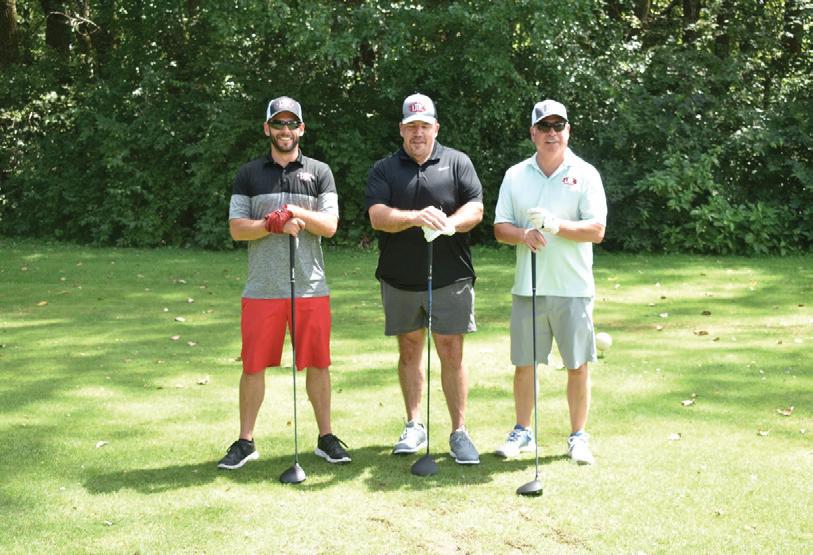


Thank You to our sponsors:
Whatever your objective was for this day, whether just fun of it, the friendly competition, the fellowship and networking, relationship building, rekindling with an old acquaintance or just catching up with old and new to the industry, I hope you were successful and looking forward to next year. The TREE Fund organization wants to thank the Indiana Arborist Association Board and the membership for the continued success of this annual commitment. We look forward to building on our successes together in the future.

Page 19
Southworth Ford Altec Progress Rail/Kershaw Xanderbuilt Tree Arbor Metrics Solutions Townsend Tree Bayer Jud Scott Consulting Lewis Tree Jaraff Bryan Equipment CNUC Stump Sprouts LLC Crestview Golf Course QUEST Vermeer Bandit Industries Billington Inspections Indigo Tree Consulting Arbor Metrics Solutions

Join Us for the IAA’s 76th Annual Conference January 24-26 Indianapolis Marriott East For registration and sponsorship opportunities visit www.indiana-arborist.org (Seedetailsinside-page16)
P.O. Box 946 Cicero, IN 46034












 President Jon Xanders, Xanderbuilt Tree care
Jon
Jon Xanders, IAA 2022 Board President and Certified Arborist doing what he does best.
Photo credit: Ashley Mulis
President Jon Xanders, Xanderbuilt Tree care
Jon
Jon Xanders, IAA 2022 Board President and Certified Arborist doing what he does best.
Photo credit: Ashley Mulis










 CeremonyPhotoofCrownhillHeritageFoundation Arboretum Director Carrie Tauscher
CeremonyPhotoofCrownhillHeritageFoundation Arboretum Director Carrie Tauscher

















































